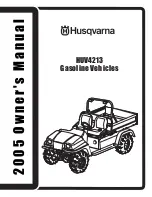
10
SECTION 2
GENERAL OPERATING INFORMATION
2.1 NEW VEHICLE “BREAK-IN” PROCEDURE
To obtain long term, trouble free service from your vehicle,
observe the following break-in guidelines:
1. Vary the speed of the vehicle for the first tank of fuel.
Avoid full throttle operation during break-in period.
2. Check engine and transmission oil levels daily during
break-in period.
3. Change the transmission oil after initial 20 hours of opera-
tion. Failure to do so can result in damage to the transmis-
sion bearings or gear surfaces. Refer to Section 6.2.3 and
6.2.4 for transmission oil changing instructions.
4. Change the engine oil in the Kohler or Briggs engine after
the first 20 hours of operation. Refer to Section 6.1.3
of this manual and the oil change section of each engine
owner’s manual for oil change information.
5. Check the idler chain adjustment each day before driving
the vehicle, and after the initial 2 hours of operation. Refer
to Section 7.2.5 for idler chain inspection and adjustment
information.
6. Never overload your vehicle. Trying to steer an overloaded
vehicle can overheat the brakes. This will lead to brake fade
which means loss of steering control and the ability to stop
the vehicle. Overloading the vehicle can lead to premature
brake system failures and costly damage to drive chains,
axles or bearings. Follow the recommended load capacity
for the vehicle listed in Section 1.4.
7. Do not allow the brakes to drag, particularly during the
first 10 hours of operation. To maximize brake pad life,
start by making several low speed turns to both sides. Al-
low the brakes to cool by driving in a straight line. Repeat
the low speed turns. Allow the brakes to cool again. This
procedure will properly seat the brake pad friction material
to the brake disc. The handlebar should be kept centered
during straight ahead operation. Dragging the brakes will
cause overheating of the brake components and result in
brake fade.
2.2 PRE-OPERATION CHECKS
Carefully follow the engine manufacturer’s recommended
pre-operation/daily checks as well as the following:
1. Check the fuel level in the see-through tank located under
the driver’s seat.
2. Check the air pressure in all tires. NOTE: Improperly
inflated tires can cause the vehicle to pull to one side,
requiring constant steering correction. See Section 7.2.6
for tire pressure specifications.
3. Test the operation of the finger grip throttle control by
squeezing it to the fully open position and releasing it. The
throttle must operate smoothly and return automatically to
the fully closed position. Take the vehicle to an ARGO
dealer if the twist grip requires adjustment.
4. Check hand operated brake lever on left hand steering bar
for braking capability Section 7.3.5. Check steering handle
bar travel to the left and to the right for steering capability.
5. Check the engine intake and exhaust screen for obstruc-
tions. Clear any debris that has accumulated.
2.3 CARRYING PASSENGERS AND CARGO
1. Keep cargo as low as possible and evenly distributed.
2. Use extreme CAUTION when negotiating inclines with a
loaded vehicle. Heavy loads and high loads decrease the
stability of the vehicle and may cause it to roll. Be pre-
pared to shift occupant weight and load forward or have
passengers get out of the vehicle to climb an incline.
3. Secure cargo to prevent it from shifting while driving.
4. Do not mount any heavy fixtures to the upper body with
out
support to the vehicle frame. The added weight may cause
body deformation that could result in the tires rubbing
through the body.
The rear compartment capacity of all 6 wheel ARGO
vehicles is 65 kg (140 lbs.) MAXIMUM. Exceeding
this weight limitation will decrease the stability of the
vehicle on inclines and increase the possibility of roll-
ing over backwards when climbing a grade.
Do NOT
exceed this weight in the rear compartment.
Make sure all passengers riding in an ARGO equipped
with tracks and ice cleats are informed to keep hands,
feet and clothing inside the vehicle, well away from
the tracks and ice cleats, while the ARGO is in motion.
Serious injury or death could result from getting caught
by the ice cleats.
Содержание Frontier 600 6x6
Страница 70: ...62 NOTES...
Страница 71: ...63 NOTES...
















































